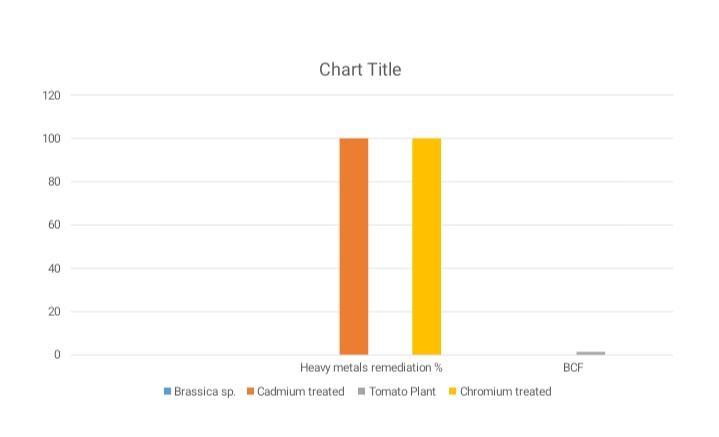
ISSN:


ISSN:
Pragya Shah (Ph.D Botany) Rabindranath Tagore (Aisect) University Chikload Road, Bangarasiya Bhopal (M.P.)

Abstract: The original laboratory work done by Pragya Shah on Phytoremediation technology shows that Phytoremediator plants have maximum capacity of Phytoremediation technique.Heavy metal like lead Pb, cadmium Cd, Cr ie Chromium are dangerous for living beings, plants etc,if present in environment,soil, water makes a person ill.Mustard plant(Brassica juncea,nigra), Tomato plant (Solenum lycopersicon) are Phytoremediator plants showing maximum remediation of heavy metals.Mustard shows higher germination rates.Tomato(Solanum lycopersicon)BCF value is 1.43>1showing higher potential of Phytoremediation.Mustard plant(Brassica juncea) and Tomato plant ie Solanum lycopersicon showing higher rates of remediation of heavy metals ie 99.99% showing higher potential of Phytoremediation technique.
Keywords: Phytoremediation, heavy metals, Plants, Mustard, Tomato.
Phytoremediation is the use of plants and associated soil microbes to reduce the concentrations of contaminants in the environments.It is a relatively recent technology and is perceived as cost effective,efficient ,novel, eco friendly and solar driven technology with good public acceptance. Phytoremediation is an area of active current research.New efficient metal hyperaccumulator's are being explored for applications in phytoremediation and phytomining .Molecular tools are being used to better understand the mechanisms of metal uptake,translocation ,sequestration and tolerance in plants.Phytoextraction (Accumulation), Phytostabilisation By Immobilisation, Phytovolatalization By Transpiration, Rhizofiltration By roots and by precipitation,Phytodegradation By microbes present in rhizosphere.BCF>1ie1.43 or ranging from 0.6 1than plants has maximum potential for Phytoremediation.Higher heavy metal remediation rates ie 99.99% shows the potential of plants for Phytoremediation, cleaning air, water, soil and environment at higher rates and percentage.
Is to show BCF and heavy metal remediation at maximum and higher percentage with Phytoremediation technology
Plants are treated with heavy metals ie Pb, C d, Cr.And keeping it for days, months.After few weeks or days by making solutions, observed by Atomic Absorption Spectrophotometer ie AAS.
BCF value is greater than 1shows higher potential of plants for Phytoremediation.Their heavy metals remediation rates are also very high 99.99% suggest the plant potential to clean air, water,soil and acts as Phytoremediator Plants doing Phytoremediation at higher rates and percentage.
TABLE1 Mustard (Brassicasp) and Solanum lycopersicon Tomato plant Heavy metal remediation rate in percentage and BCF value
Heavy metal remediation in percentage
Brassica sp. Cadmium treated 99.998%, with initial conc.100, final conc.0.00192, Solanum lycopersicon Chromium treated 99.99%with initial conc.100, final conc.0.0030,BCF 1.43 with shoot conc.0.0043.
BCF 1.43greater than 1., have high potential for Phytoremediation.
International
Engineering Technology (IJRASET
ISSN: 2321 9653; IC Value: 45.98; SJ Impact Factor: 7.538

10 Issue IX Sep 2022 Available at www.ijraset.com
GRAPH 1 Mustard(Brassica sp)and Solanum lycopersicon Tomato plant Heavy metal remediation rate in percentage and BCF value.

1) Phytoremediation is a green technology for removal of heavy metals and harmful contaminants from the environment.
2) Useful in Agriculture Phytoremediation is a technique of employing green plants and their associated microorganisms,soil amendments and agronomic practices to remove,inhibit or neutralize hazardous environmental contaminants,so useful in agriculture.
3) Useful in Agricultural and nutritional sciences and food industry.
4) Useful in Atomic energy sector Nuclear weapon testing(release of mainly 14C,137Cs,90Sr,and 95Zr) production (release of mainly 137Cs,106Ru,95Zr,)and nuclear power production.
5) Useful in Environmental Chemistry,waste management,and mine reclamation Applied where the soil or static water environment has become polluted or is suffering ongoing chronic pollution eg where Phytoremediation has been successfully include the restoration of abandoned metal mine workings and sites where polychlorinated biphenyles have been dumped during manufacture and mitigation of ongoing coalmines,discharges reducing the impact of contaminants in soil,water,or air.Contaminants such as metals,pesticides,solvents explosives and crude oil and it's derivatives have been mitigated in phytoremediation projects worldwide.
6) It is an insitu and exsitu technique helpful in tissue culture.
7) Phytoremediation is a groundwater remediation technologies.
8) Useful in national institute of environment,health sciences,helpful in environmental cleanup ENVIS centre.
Tomato ie Solanum lycopersicon and Mustard ie Brassica sp.juncea is a Phytoremediator Plants with higher remediation of heavy metals ie cadmium Cd Cr ie Chromium.Their BCF>1and remediation rate is also 99.99%,means Plants has higher potential for remediation of heavy metals and they have a potential of cleaning the soil, water, air and environment.
Supported nationally and internationally

ISSN: 2321 9653; IC Value: 45.98; SJ Impact Factor: 7.538
Volume 10 Issue IX Sep 2022 Available at www.ijraset.com
[1] Ashraf S et al E toxicol environ Saf2019, Phytoremediation of environmental sustainable way for reclamation of heavy metal polluted soils 2019.
[2] Wanganekar Omkar and Thakre et al 2019,Rev. On Study of Phytoremediation Techniques and it's applications IJSRR 8(2) April June 2019.
[3] Hazrat Ali, Ezzat Khan et al,A Rev on Phytoremediation of heavy metals Concepts and applications (2013) 869 881.
[4] Asma Yaqoob,Faiz ul Hussain Nasim Ayesha Sumreen progresses and limitations Vol 14 No 3p 191 206,2019.
[5] Amanullah Mahar Ping Wang A Rev.on Challenges and Opportunities in the Phytoremediation of heavy metals contaminated soils 126(2016) 111 121.
[6] Ahmed Ibrahim Galadima,Salaiman Mohammed,A Rev. On Phytoremediation:A Preeminent alternative method for Bioremoval of heavy metals from Environment 10 Issue 1 (2018) 59 71.
[7] Shobhika Parmar and Vir Singh,A Rev.on Phytoremediation Approaches for heavy metal Pollution 2015 (2) (2) 139.
[8] Rohmaan Razzaq,A Rev on Phytoremediation: An environmentally friendly technique J.environment and Chem 2017,4,2.
[9] E E Etim,ARev. On Phytoremediation and Mechanisms 2012,2(3):12 136.
[10] S Muthusaravanan,N Savarajasekar et al,A Rev.on Phytoremediation of heavy Metals: Mechanisms, Methods and Enhancements.
